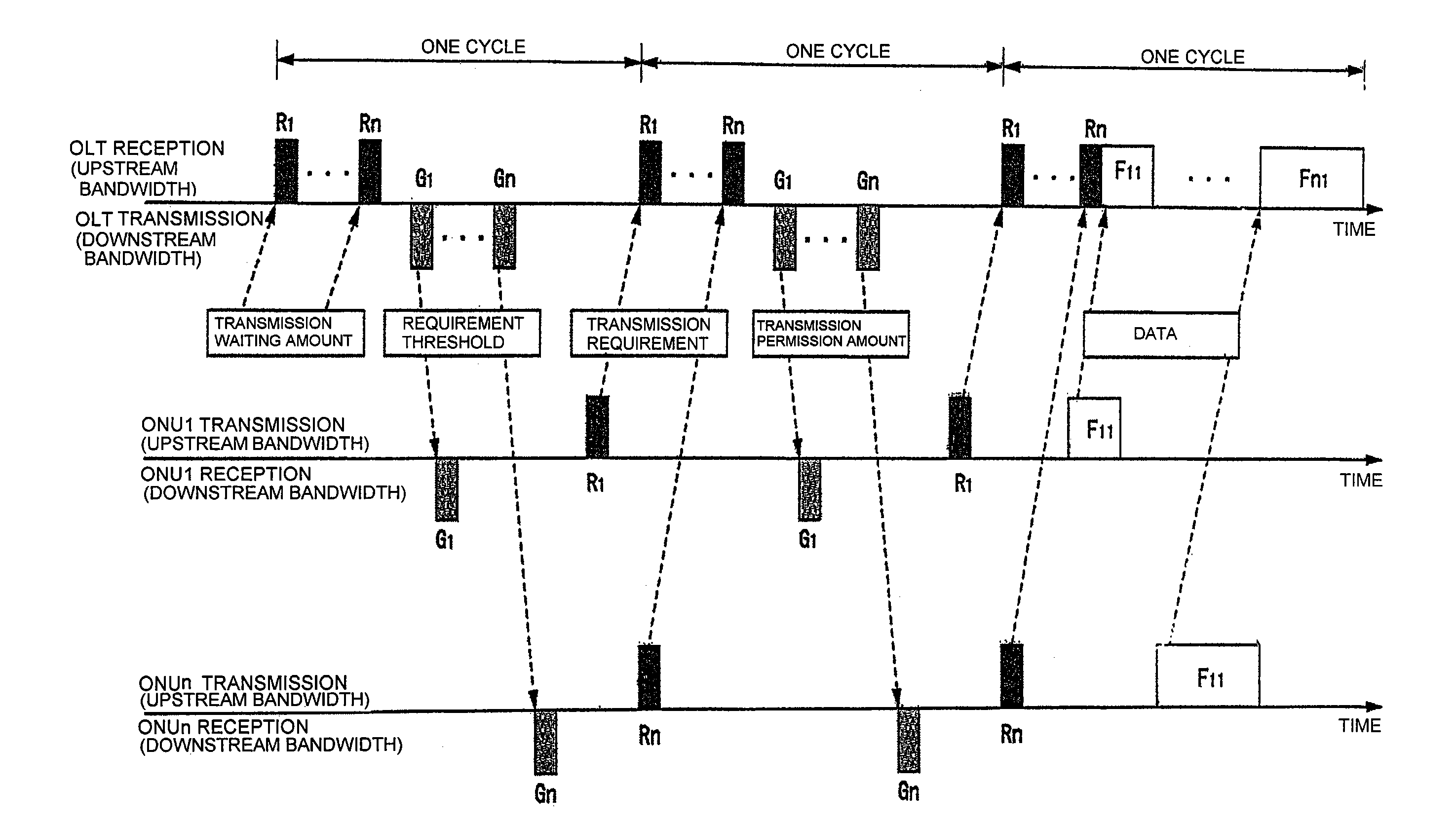Bandwidth allocation method and passive optical network system
a technology of optical network and allocation method, applied in data switching networks, instruments, frequency-division multiplexes, etc., can solve the problem of inability to control the convergence of the allocated bandwidth on the target bandwidth, the inability to specify and the inability to adjust the upper limit of the transmission requirement. problem, to achieve the effect of minimizing the mismatch between the transmission requirement and the transmission permission amoun
- Summary
- Abstract
- Description
- Claims
- Application Information
AI Technical Summary
Benefits of technology
Problems solved by technology
Method used
Image
Examples
first embodiment
[0050](First Embodiment)
[0051]A method in which an OLT calculates a requirement threshold based on a time average allocated bandwidth obtained from allocated bandwidths of past predetermined cycles of ONU will be described below. For a constant data transmission bit rate, the following amount, bandwidth, and the like may be processed by a data amount or a time. An i-th ONU is expressed by ONUi, and hereinafter a suffix i is added to a parameter of the ONUi. A difference ei between the time average allocated bandwidth of the ONUi and a target bandwidth obtained from a communication state of each ONU is calculated. A PID (Proportional Integral Derivative) computation amount xi is calculated from the following equation:
[0052][Equation1]xi=Pi(ei+Ii∫eiⅆt+Diⅆeiⅆt)(1)
where Pi, Ii, and Di are predetermined parameters. The OLT can control the way of the convergence of the allocated bandwidth on the target bandwidth by adjusting values of Pi, and Di (for example, an optimum value is obt...
second embodiment
[0082](Second Embodiment)
[0083]FIG. 5 is a sequence diagram illustrating an example of a bandwidth allocation method which is performed by a passive optical network system according to a second embodiment of the disclosure. The second embodiment includes a first step, a second step, and a third step in order, and is characterized in that the ONU calculates the requirement threshold zi based on the time average allocated bandwidth obtained from the allocated bandwidths of the past predetermined cycles. The point which is different from that of the first embodiment will specifically be described below.
[0084]First, each ONUi calculates and stores each time average allocated bandwidth. Each of the ONU1 to ONUn, describes a transmission waiting amount ci in the report frame and notifies the OLT of the transmission waiting amount ci in the timing of which the OLT notifies. The OLT calculates a target bandwidth fi based on the transmission waiting amount ci of each of the ONU1 to ONUn. The...
PUM
 Login to View More
Login to View More Abstract
Description
Claims
Application Information
 Login to View More
Login to View More - R&D
- Intellectual Property
- Life Sciences
- Materials
- Tech Scout
- Unparalleled Data Quality
- Higher Quality Content
- 60% Fewer Hallucinations
Browse by: Latest US Patents, China's latest patents, Technical Efficacy Thesaurus, Application Domain, Technology Topic, Popular Technical Reports.
© 2025 PatSnap. All rights reserved.Legal|Privacy policy|Modern Slavery Act Transparency Statement|Sitemap|About US| Contact US: help@patsnap.com



